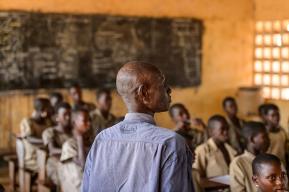Idea
What big teeth you have: the wolf in children’s books

Debra Mitts-Smith
Author, professor emeritus, and expert on children’s and young adult literature, Mitts-Smith holds a Ph.D. in Library Science from the University of Illinois at Urbana-Champaign, the United States. She is a regular contributor to International Wolf magazine and the author of Picturing the Wolf in Children's Literature (2010).
Open any number of children’s books and you will find wolves in mobcaps, top hats, and overalls. Some are thinly disguised humans while others are thinly disguised wolves. And while most play the role assigned to them, some rebel and insist on telling their side of the story.
Whether at the crossroads, the door, in pastures or farmyards, the wolf of children’s books has been first and foremost a predator. In cautionary tales such as Little Red Riding Hood, The Three Little Pigs, and The Kid Goats as well as in many of Aesop’s fables dating back to ancient Greece, the wolf’s predation is a metaphor for dangerous humans and dangerous human behavior. The wolf’s targets (the weak, the young and the ailing) and tactics (flirting, deception, and threats) render him treacherous, immoral, and deserving of punishment.
Yet the wolf is also a real animal, a large carnivore once common to the Northern hemisphere. For Europeans and Euro-Americans, the real wolf was a threat to humans and their livestock, giving credence to their fears and helping to blur the lines between the real and symbolic.
Variants of Little Red Riding Hood have been found across Europe, Asia and North America
The story of Little Red Riding Hood, a young girl who meets a wolf on her way to visit her bedridden grandmother, deserves special attention. Variants of this tale have been found across Europe, Asia and North America. The versions found in children’s books draw primarily from two sources: Charles Perrault’s 1697 collection of French oral folktales and the Brothers Grimm’s 19th century collection of German folktales. Perrault’s version ends with the wolf devouring both the grandmother and the little girl while in the Grimms’ version, a hunter kills the wolf and rescues the grandmother and granddaughter from the wolf’s belly. Chinese-American illustrator Ed Young’s 1989 picture book, Lon Po Po: A Story from China, introduced a Chinese variant, where three young sisters outwit the wolf.
A new wolf in town
Towards the end of the late 1800s, as efforts to eradicate the wolf from the western United States were beginning to succeed, several children’s stories featuring wolves in a more compassionate light were published. These included Canadian author and illustrator Ernest Thompson Seton’s short story (1898) Lobo, the King of the Currampaw, and American novelist Jack London’s The Call of the Wild (1903) and White Fang (1906). Although the wolves in these stories were not realistic, they were admirable.
Profound changes in the depiction of the wolf in Western children’s books did not occur however until the second half of the twentieth century. Several factors, including the beginning of scientific studies of the wolf, its near extinction, and a change in the wolf’s legal status from bounties to protection, helped contribute to the proliferation of popular pro-wolf books.
The near extinction of the wolf contributed to the proliferation of popular pro-wolf books
The dissemination of information about real wolves has led to more nuanced depictions of wolves in nonfiction and fiction. These works do not deny the wolf’s predation, but instead reduce it to but one aspect of the social animal that plays a vital role in the ecosystem.
In Face to Face with Wolves (2008) American writer and photographer Jim Brandenburg focuses on life in the pack, stressing the ways in which the lives of wolf pups are similar to those of human children. Roseanne Parry’s fictional biography A Wolf Called Wander (2019) recounts the story of a real wolf who traveled over 1,600 kilometres in search of a mate, whereas When the Wolves Returned (2008) by American writer Dorothy Hinshaw Patent shows what happens when wolves are restored to former habitats.
Where the lone wolves of traditional tales pose a threat, those of contemporary nonfiction and realistic fiction are vulnerable, not threatening. Drawing on scientific studies of wolves, these works redefine what it means to be a predator by focusing on the dangers and challenges wolves face.
From wolf children to werewolves
Two wolf lore motifs that have become a source of inspiration for authors and illustrators of children’s books are children raised by wolves and werewolves. These stories rewrite not only the wolf but also the wolf’s relationship with young people.
English author Rudyard Kipling opens The Jungle Books (1894-95) with a wolf pack rescuing the human toddler Mowgli. In American writer Jean Craighead George’s (1972) Julie of the Wolves a wolf pack rescues the young protagonist from dangerous humans.
Other stories such as American writer David McPhail’s A Wolf’s Story (1981) feature children who rescue a wolf. And in American illustrator Matthew Cordell’s The Wolf in the Snow (2017), the rescue is reciprocated: a young girl rescues a wolf pup and is, in turn, rescued by the pup’s pack.
Shapeshifters or humans that transform into wolves are found across many cultures
Shapeshifters or humans that transform into wolves are found across many cultures and bear different meanings. Authors of Japanese manga often use shapeshifters to explore the human connection with nature and gender roles.
In contrast, in Western children’s books, the wolf shape becomes the means through which child protagonists can express themselves, making them the fiercest of fictional wolves. In American author and illustrator Maurice Sendak’s Where the Wild Things Are (1963), a boy, Max, dons a wolf costume and unleashes his inner beast while Ulysses in French writer and illustrator Grégoire Solotareff’s Le Masque (2001) wears the hide of a dead wolf to protect children from human predators.
Wolf tales also lend themselves well to parodies. In American author Jon Scieszka and illustrator Lane Smith’s The True Story of the Three Little Pigs by A. Wolf (1989), the wolf, claiming to be misunderstood, explains his encounters with three pigs. Using traditional wolf tales and the animals who populate them, French writer and illustrator Geoffroy de Pennart has created parodies such as Chapeau Rond Rouge (2005) that modernize the traditional tales, emphasize humor over moral lessons, and rewrite the wolf.
The largest children’s library in the world is in Munich
Housed in an 15th-century castle in Munich, Germany, the Internationale Jugendbibliothek is more than a library: it is a festival of the written word, offering a full calendar of events and a lively array of exhibitions, workshops and concerts.
Begun in 1949 and recently refurbished, it is the largest library of children’s literature in the world. Home to 27,000 books in more than 24 languages, they can be borrowed free of charge. Stock is constantly updated and new and award-winning books can always be found.
Created shortly after the end of the Second World War, the library recognizes children’s and youth literature as essential to the cultural life of a society. Its founder, Jella Lepman, a children's author and journalist who was exiled to the UK during the Second World War, made it her mission on her return to Germany to help children traumatized by the war. Her way of helping them was to promote cultural literacy among children and young people.
As well as lending books, this institution offers a wide range of cultural activities including readings, round tables and conferences, as well as an international literature festival. Recent offerings for families include a display of animal fable illustrations from Tanzania, a concert for children by the Bavarian Radio Symphony Orchestra based on a popular children’s book, and a reading by German-Nigerian author Efua Traoré. Educational projects allow teenagers to delve into important topics: a week-long exploration of the effects of book burning culminates in a theatre performance.
Seventy-five years after it was founded, the Internationale Jugendbibliothek can pride itself on being both a local centre for children's education and leisure activities and an unrivalled international resource for children's literature.






